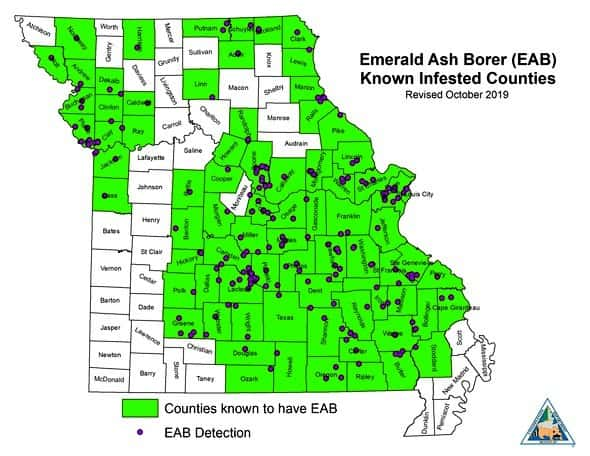The Missouri Department of Conservation (MDC) reports the presence of Emerald Ash Borer (EAB) in 16 new counties- including three in the immediate KMMO listening area- across Missouri.
According to a news release, collaborative efforts by MDC staff, Missouri Department of Agriculture inspectors and USDA Animal and Plant Health Inspection Service officers, EAB has been detected in Benton, Boone, Cooper, Douglas, Holt, Howard, Howell, Linn, Montgomery, Morgan, Nodaway, Osage, Ozark, Pettis, Putnam, and Randolph counties this year.
Since EAB was first detected in Missouri in July 2008, this tree-killing pest has spread to a total of 75 Missouri counties and the City of St. Louis.
EAB is a small, metallic green beetle native to Asia that attacks all species of ash trees, including Missouri’s native green ash and white ash. In its larval stage, the insect kills ash trees by feeding on the vascular tissues just under the bark, slowly cutting off the trees’ flow of water and nutrients. EAB kills more than 99 percent of the ash trees it attacks.
EAB will likely be found statewide within the next few years, prompting MDC Forest Entomologist Robbie Doerhoff to urge Missourians with ash trees in their yard to make a plan now to either remove those trees or treat them with an insecticide.
“EAB-killed ash trees quickly become brittle and dangerous, so it’s time to consider your options when it comes to ash trees, especially those located near buildings and driveways,” said Doerhoff.
Ash trees typically show a pattern of declining health for two to four years before being killed by EAB. Woodpecker damage, sprouts growing from the main trunk, and major branch loss can all suggest EAB is present.
If you have an ash tree in your yard that mostly appeared healthy this growing season, it may be a good candidate for treatment next spring or early summer.
“Make sure you know what insecticide you or your arborist is using. Not all insecticides are effective or recommended, and treatment options vary by tree size,” said Doerhoff.
Find more information on recommended insecticides in MDC’s EAB Management Guide for Missouri Homeowners, visit MDC’s website at mdc.mo.gov.
Map provided by the Missouri Department of Conservation.


